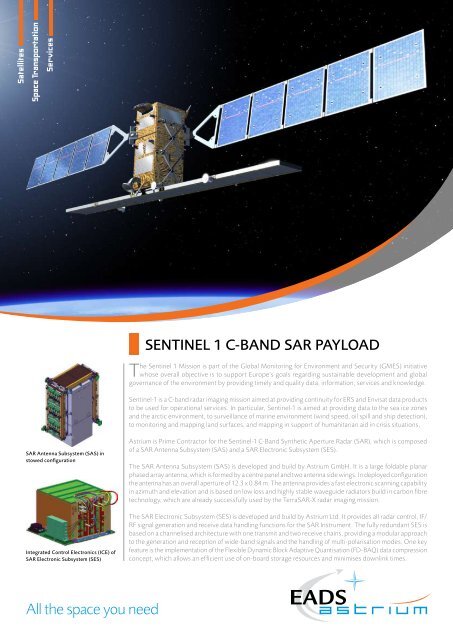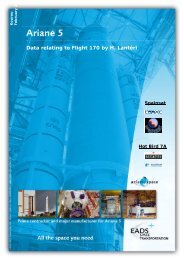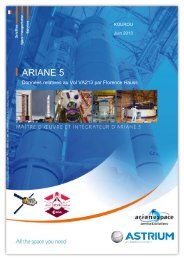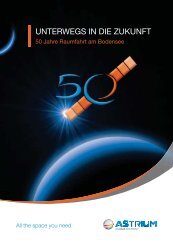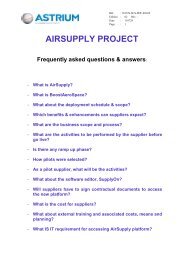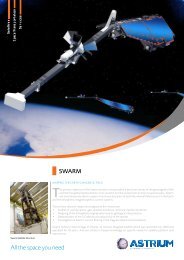SENTINEL 1 C-BAND SAR PAYLOAD All the space you need
SENTINEL 1 C-BAND SAR PAYLOAD All the space you need
SENTINEL 1 C-BAND SAR PAYLOAD All the space you need
Create successful ePaper yourself
Turn your PDF publications into a flip-book with our unique Google optimized e-Paper software.
<strong>SAR</strong> Antenna Subsystem (SAS) in<br />
stowed configuration<br />
Integrated Control Electronics (ICE) of<br />
<strong>SAR</strong> Electronic Subsystem (SES)<br />
<strong>All</strong> <strong>the</strong> <strong>space</strong> <strong>you</strong> <strong>need</strong><br />
<strong>SENTINEL</strong> 1 C-<strong>BAND</strong> <strong>SAR</strong> <strong>PAYLOAD</strong><br />
The Sentinel 1 Mission is part of <strong>the</strong> Global Monitoring for Environment and Security (GMES) initiative<br />
whose overall objective is to support Europe’s goals regarding sustainable development and global<br />
governance of <strong>the</strong> environment by providing timely and quality data, information, services and knowledge.<br />
Sentinel-1 is a C-band radar imaging mission aimed at providing continuity for ERS and Envisat data products<br />
to be used for operational services. In particular, Sentinel-1 is aimed at providing data to <strong>the</strong> sea ice zones<br />
and <strong>the</strong> arctic environment, to surveillance of marine environment (wind speed, oil spill and ship detection),<br />
to monitoring and mapping land surfaces, and mapping in support of humanitarian aid in crisis situations.<br />
Astrium is Prime Contractor for <strong>the</strong> Sentinel-1 C-Band Syn<strong>the</strong>tic Aperture Radar (<strong>SAR</strong>), which is composed<br />
of a <strong>SAR</strong> Antenna Subsystem (SAS) and a <strong>SAR</strong> Electronic Subsystem (SES).<br />
The <strong>SAR</strong> Antenna Subsystem (SAS) is developed and build by Astrium GmbH. It is a large foldable planar<br />
phased array antenna, which is formed by a centre panel and two antenna side wings. In deployed configuration<br />
<strong>the</strong> antenna has an overall aperture of 12.3 x 0.84 m. The antenna provides a fast electronic scanning capability<br />
in azimuth and elevation and is based on low loss and highly stable waveguide radiators build in carbon fibre<br />
technology, which are already successfully used by <strong>the</strong> Terra<strong>SAR</strong>-X radar imaging mission.<br />
The <strong>SAR</strong> Electronic Subsystem (SES) is developed and build by Astrium Ltd. It provides all radar control, IF/<br />
RF signal generation and receive data handling functions for <strong>the</strong> <strong>SAR</strong> Instrument. The fully redundant SES is<br />
based on a channelised architecture with one transmit and two receive chains, providing a modular approach<br />
to <strong>the</strong> generation and reception of wide-band signals and <strong>the</strong> handling of multi-polarisation modes. One key<br />
feature is <strong>the</strong> implementation of <strong>the</strong> Flexible Dynamic Block Adaptive Quantisation (FD-BAQ) data compression<br />
concept, which allows an efficient use of on-board storage resources and minimises downlink times.
7464tl apr © Astrium 2010, images © Astrium 2010, © ESA 2010<br />
Customer European Space Agency/Thales Alenia Space<br />
Mission Ocean, Ice and Land Monitoring<br />
Orbit Polar sun synchronous orbit at 700km<br />
Spacecraft PRIMA-type Platform<br />
Payload C-band <strong>SAR</strong><br />
• Instrument mass: 930kg<br />
• Instrument dimensions: 12.3m x 0.84m x 0.3m in deployed<br />
configuration<br />
• Instrument power consumption: 3.5kW<br />
RF Characteristics • Centre frequency: 5.405GHz<br />
• Bandwidth: up to 100MHz • RF peak power: 4.3kW<br />
• Polarisation: HH-HV, VV-VH • Duty cycle: up to 12%<br />
Measurement Modes • Stripmap mode<br />
• Extrawideswath mode<br />
• Interferometric wideswath mode • Wave mode<br />
Mission Duration 7 years<br />
Astrium Responsibilities • <strong>SAR</strong> Instrument Prime Contractor<br />
• <strong>SAR</strong> Electronic Subsystem Contractor<br />
Key Features:<br />
To satisfy <strong>the</strong> <strong>need</strong> for <strong>the</strong> wide variety of data products of <strong>the</strong> Sentinel-1 mission, <strong>the</strong> C-band <strong>SAR</strong> Instrument<br />
provides three radar imaging modes with dual polarisation capability (HH-HV, VV-VH) :<br />
• Stripmap Mode (6 selectable swa<strong>the</strong>s of 80 km each, 5 m x 5 m resolution)<br />
• Interferometric Wideswath Mode (250 km swath, 5 m x 20 m resolution)<br />
• Extra-Wideswath Mode (400 km swath, 20 m x 40 m resolution)<br />
and one single polarised ocean mode (HH or VV) :<br />
• Wave Mode (20 km x 20 km vignettes, 20 m x 5 m resolution)<br />
The Wideswath modes are both implemented as Scan<strong>SAR</strong> modes with progressive azimuth scanning (TOPS)<br />
to ensure an excellent and homogenous image quality over <strong>the</strong> complete swath. In all four measurement<br />
modes a high sensitivity (nESZ


